How to Read Credit Card Statements?
A credit card statement is a monthly report that details all the transactions made on a particular credit card account during the billing period. It includes information such as the total amount owed, the minimum payment due, the interest rate, and any fees or charges that have been applied. To read a credit card statement, it is important to review all the charges and payments carefully to ensure accuracy, compare the statement to your receipts and records, understand the interest rates and fees, and make payments on time to avoid additional charges.

How to Read Credit Card Statements?
Account summary:
The account summary section provides a quick overview of your credit card account, including your balance, available credit, and payment due date. Review this section carefully to ensure that the information is correct.
Transactions:
The transactions section lists all the purchases, payments, and other transactions made during the billing period. Make sure to review this section carefully and compare the information to your receipts and records. If you notice any discrepancies, contact the credit card company immediately.
Interest charges:
If you carry a balance on your credit card, you will be charged interest on the outstanding amount. The statement will list the interest rate and the amount of interest charged during the billing period. Understanding the interest rate is crucial to managing your finances and avoiding unnecessary interest charges.
Fees and charges:
Credit card companies may charge fees for various reasons, such as late payment fees, balance transfer fees, or cash advance fees. The statement will list any fees or charges applied during the billing period, and it is essential to review them to ensure their accuracy.
Rewards and points:
If you have a rewards credit card, the statement will include information on your rewards points or cashback earned during the billing period. Make sure to review this section and ensure that you are receiving the rewards you were promised.
Minimum payment:
The minimum payment is the amount you are required to pay to keep your account in good standing. The statement will list the minimum payment due, and it is crucial to make at least this payment to avoid late payment fees and other charges.
Payment information:
The payment information section provides details on how to make a payment, including the payment due date, the payment address, and the payment options available. Review this section carefully and make sure to make payments on time to avoid additional charges.
Fraud and disputes:
If you notice any unauthorized charges or transactions on your credit card statement, contact the credit card company immediately to report the fraud or dispute the charge.
Bottom line:
To read a credit card statement, review the charges and payments carefully, compare the statement to your receipts and records, understand the interest rates and fees, and make payments on time to avoid additional charges. It is also important to keep an eye out for any fraudulent charges and to contact the credit card company immediately if you notice any discrepancies. By understanding your credit card statement, you can better manage your finances and avoid unnecessary fees and charges.


Comments
Post a Comment